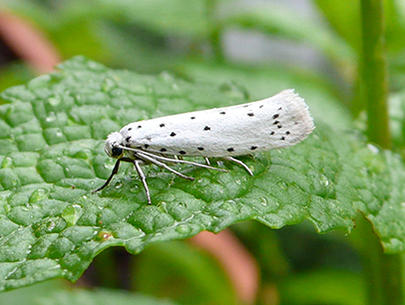
Urban moths learn to head away from the light

Instead of heading towards the light, as the proverb says, moths in areas with many artificial light sources have learnt to avoid death traps such as street lamps, according to zoologists from the Universities of Basel and Zurich.
Nocturnal insects are particularly affected by globally increasing light pollution, since their attraction to artificial light sources generally ends fatally: either they die through direct burning or through increased exposure to predators.
What’s more, artificial light affects the ecosystem of insects by interfering with their natural day-night cycle and influencing behaviour patterns such as feeding and reproduction.
However, a study published in the journal Biology Letters suggests moths in the Basel region have adapted to the changed light conditions.
Swiss researchers, led by Florian Altermatt and Dieter Ebert, assuming that natural selection would favour moths with less propensity to fly to light in urban areas, examined the small ermine moth Yponomeuta cagnagella.
Evolution
All living organisms – from humans to mountain goats to edelweiss – are distant cousins and have evolved, through random genetic mutations and the non-random process of natural selection, from a single self-replicating molecule that popped into existence by chemical chance some 3.5 billion years ago.
Natural selection is the process by which organisms with traits that are favourable for survival in their environment reproduce more than their rivals. Thus genes that build successful survival machines get passed on more than less successful genes.
Evolution via natural selection thus explains how simple organisms can, over millions of years, result in complex organisms seemingly designed for their environment.
For their experiment, they collected larvae in the Basel region in areas with low light pollution, such as the village Kleinlützel, and in areas which have been exposed to heavy light pollution, such as Allschwil or Basel City.
They then analysed the flight-to-light behaviour of almost 1,050 adult moths in the lab.
Darwinian adaption
The results show that moths from populations that have been exposed to heavy light pollution over generations have a significantly lower propensity to move towards light sources then individuals from areas with low light pollution.
Furthermore, the study shows that in both types of populations the female moths were attracted to light significantly less than their male counterparts.
The zoologists said the results suggested that natural selection had changed the animals’ behaviour.
“Flight-to-light propensity is disadvantageous for moths in light polluted areas. Adapted moths avoid the light and thus have a survival advantage. Even though this evolutionary change reduces the high mortality by artificial light, it could also have negative implications for the community,” they warned.
“A consequential reduced overall mobility of the insects could for example lead to reduced pollination of plants.”

In compliance with the JTI standards
More: SWI swissinfo.ch certified by the Journalism Trust Initiative




































You can find an overview of ongoing debates with our journalists here . Please join us!
If you want to start a conversation about a topic raised in this article or want to report factual errors, email us at english@swissinfo.ch.